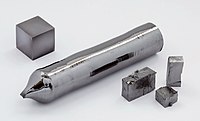
Photo from wikipedia
The preparation of the Nb coating was performed on the bare Ti–6Al–4V alloy using the double glow discharge plasma technique. It was characterized that the Nb coating exhibited a face… Click to show full abstract
The preparation of the Nb coating was performed on the bare Ti–6Al–4V alloy using the double glow discharge plasma technique. It was characterized that the Nb coating exhibited a face centered cubic (fcc) crystal structure and a pronounced (200) preferred orientation. The SEM micrograph of the cross section for the coating displayed dense microstructure with a thickness of approximately 18 µm. The critical load (Lc) of the coating was determined to be about 83.5 N by the scratch tests. The electrochemical corrosion resistance of the coating was examined in Ringer’s solution at 37 °C by a series of electrochemical techniques, including open-circuit potential (OCP), potentiodynamic polarization, electrochemical impedance spectroscopy (EIS), and a Mott–Schottky analysis. As the result of the potentiodynamic polarization, the Nb coating possessed a more positive corrosion potential and lower corrosion current density than the Ti–6Al–4V substrate. EIS fitting date showed that the Nb coating always possessed a higher value of impedance and lower effective capacitance than those of the substrate during the five days of immersion testing. The main component of the passive film developed on the Nb coating was Nb2O5, confirmed by an X-ray photoelectron spectroscopy (XPS) analysis. A Mott–Schottky analysis demonstrated typical n-type semiconductor characteristics of the Nb coating, and both the donor density and flat band potential of the coating were lower than those of the substrate at all the given formation potential. These investigations demonstrate that the Nb coating can significantly improve the corrosion protection of uncoated Ti–6Al–4V and is thus a promising coating for the surface protection of bioimplants.
Journal Title: Coatings
Year Published: 2019
Link to full text (if available)
Share on Social Media: Sign Up to like & get
recommendations!